- Bernard Preston homepage
- Honey Mead
- Cherry-guava Honey Mead
Cherry-guava honey mead
Cherry-guava honey mead preserves the important polyphenols in the fruit for enjoyment and wellness during the whole year.
Preserving food is as ancient as the Egyptians. One lesser-known benefit is that those that are fermented, like sauerkraut and cherry guava honey mead also act as powerful probiotics contributing to the friendly flora in the gut.
Researchers emphasise that it's not only the number of bugs in the colon but also the diversity that counts; that means enjoying as many different natural probiotics as we can find.
Each has its own peculiar colonies of bacteria, viruses and yeasts.
On the left of the cherry-guava honey mead you can see a carboy of wheat beer fermenting; and others in the background. Kefir[2] remains to my mind the simplest and cheapest of all the probiotics to make; just five minutes.
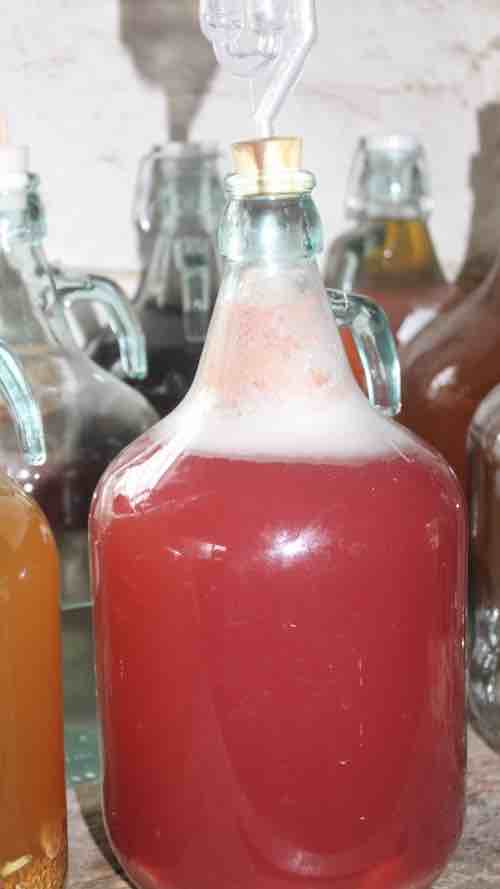 Cherry-guava honey mead from the boiled and strained juice.
Cherry-guava honey mead from the boiled and strained juice.For a dry mead aim for an initial SG of 1.100. They take longer to mature and taste fairly harsh if drunk in less than six months; better a year or more.
For a sweeter mead, the SG should be between 1.120 and 1.150; better for the beginner.
Ingredients
- 4.5L demijohn
- 4L cherry-guava extract
- Unchlorinated water
- 1.0kg natural honey
- 1/5th lemon including the pulp
- 2 cloves
- 1/5th hand of ginger
- Cup of herbal tea brewed with 4 guava leaves
- Small chunk of honey comb with fresh pollen
- 1/5th tsp of white yeast
Go for it
- Dissolve the honey in warm water.
- Brew the tea for 15 minutes; cool.
- Add all the ingredients to the carboy to half full.
- Shake the whole carboy vigorously for 10 minutes to aerate the liquid[5].
- Fill with warm, unchlorinated water leaving an 8cm gap.
- Add the yeast to a few tablespoons of warm water and allow to hydrate for 20 minutes.
- Measure the SG and fit the bubbler.
Adding a small chunk of comb with fresh pollen would provide more nutrients for the yeast; prick open any sealed cells with honey.
The initial specific gravity was 1.08 on 27th November, 2022. The taste was spectacularly good though rather too sweet of course; fermentation of the sugars had not even started.
All yeast products have a mind of their own; just talk to bakers but these are the guidelines for when to rack your mead.
- I usually do my first rack 6 to 12 weeks after preparing the raw mead.
- I rack it a second time after it has cleared which could be half a year or more later.
- If it was very clear at the 2nd rack then after a week or two one could move to bottling.
- If it is not clear then another rack after a few more months is needed, followed by bottling.
There is absolutely no harm in starting to drink your cherry-guava honey mead before it has cleared; the living yeast cells act as probiotic for our colons. Nevertheless the flavour improves the longer you leave it to mature.
For a sweet mead add up to 1.6kg of natural honey.
Cherry guavas
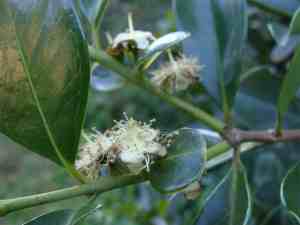
Cherry-guavas are a controversial fruit. Depending on where you live they can be extremely invasive; so we do not recommend growing them in hot coastal areas. But in cooler climes at altitude they are a wonderful food for both humans and wildlife alike.
The whole subject of invasive alien species is something that we all should make time to consider. Many plants and insects have great benefits; but do they outweigh the potential for damage to the environment? We have found that at 4000' asl cherry-guavas are not a problem. In Hawaii I believe they are a real menace.
The scent of the flowers as you pass the trees in bloom is unsurpassingly wonderful; as are the jellies, jams and meads made from the fruit.
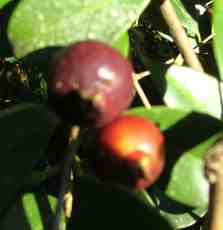
The fruit is about 15mm in diameter; a huge abundance. They are simple to reap by walking under the tree with a bucket; running one's hand down the branches plucks the ripe berries off very easily.
They are slightly tart with a terrific flavour; eat them raw, make jellies and meads. The fruit is rich in many polyphenols that prevent oxidative-stress; meaning they help to stop the formation of malignant tumours and preserve our brains.
Early on I was unable to tell whether the raw or boiled made a better mead; so we drank them both ways; when mature it became apparent that the former was smoother and nicer.
This alternative guava honey mead is made with the uncooked fruit; it's quite different and one of my favourite melomels.
Nutrition is a mystery slowly being unraveled but still shadowed in confusion. Eggs are out, no that's not right; the heart association now says we must eat them regularly. Butter, margarine and fat of animal origin are all bad; or are they good? No one seems to be sure.
And so it is with cooked versus raw.
The lycopenes are better released and absorbed apparently after being heated, giving greater protection against malignant tumours. No one is quite sure about cherry-guava mead. Never cook the honey; that's certain.
Making cherry-guava honey mead is a hobby of patience; time has to pass. Certain equipment is needed and will greatly enhance the quality of your brew; and ease your way.
This is our basic basic mead making equipment. A hydrometer for measuring the specific gravity and an automatic syphon are important.
Extracting the juice
The good wife makes cherry-guava jelly[3]; the very best I have ever tasted. First she would boil the fruit in a little water until it is squishy. Then using a potato masher she would pulp the whole mess; a muslin bag strains off the mother liquor.
The remaining juice in the pulp can be further extracted by adding water and then straining off the liquid for use in fermenting a mead for example; or adding it to a smoothie perhaps.
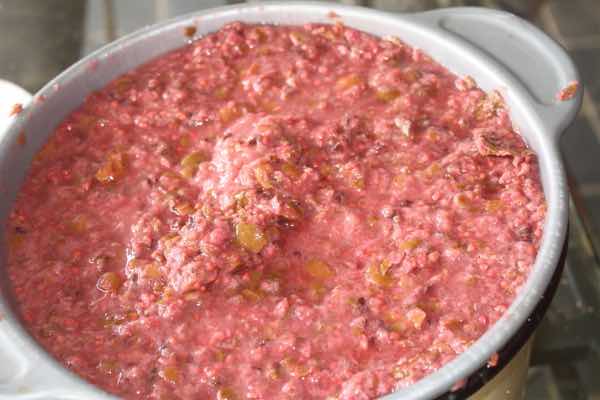
You can use the concentrated juice to either make jelly by boiling off a lot of the water or turn it into this cherry-guava honey mead. They are both of unsurpassed merit.
After straining a very large amount of goodness remains in the pulp; add water several times and extract off this potentially lost juice which can be used to make a mead.
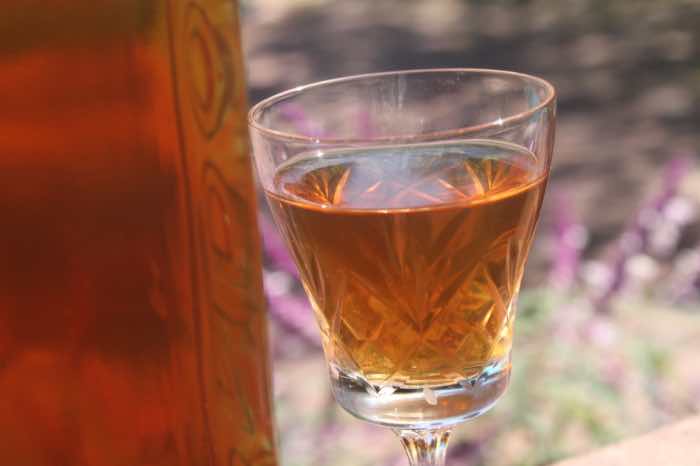
My frank opinion at this stage is that the mead made from the raw juice and pulp is superior to that from the cooked and strained juice; but this is still very good. I will continue to make it both ways.
Many coloured foods
Researchers have found that those enjoying many coloured foods suffer far less disease and live much longer. I cannot say that any one is more important but every male needs to know about the reds. Lycopenes are the phytonutrients that give men 50% protection against malignant tumours of the prostate gland; that's massive.
Flavonols too have a profound affect on cognition in the elderly[4].
Homemade wines, beers and meads are excellent probiotics; unpasteurised they are alive with friendly yeast cells. Re-establishing the intestinal flora is probably the most important subject being researched and reported right now in the nutritional literature.
The sulphites that are used to preserve commercial wines and many other foods have earned themselves the dubious "allergen of the year" award[6]. We now stick to cherry-guava honey mead and its many cousins for our tipple.
In 23 litres use 8kg of honey for a sweet mead.
6.9kg for a semi-dry.
That is roughly 1tsp of honey less per glass of 125ml; about 6g.
Blue zones
In four of the the five blue zones of the world where longevity is the word, they drink alcohol in moderation; one to three glasses of local red wine daily would be typical. Mead makes a great servant but a very bad master remember.
Loma Linda is the exception; the Adventists are strict teetotalers.
Organic fruit
“Grapes are sprayed with massive amounts of pesticides; and wine is made from grapes."
- Jenny Lefcourt, importer of natural wines
The joy of brewing your own wines, in this instance a cherry-guava honey mead is that you can rest assured that they are free of all pesticides and preservatives. Made from your own fruit and honey you know that they are truly natural and organic.
Cherry-guava honey mead
Cherry-guava honey mead can be made with either the raw fruit or the boiled and then extracted juice.
Sometimes it is called the China Guava; a category 1b invader at sea level[1].
When browsing use right click and "Open Link in New Tab" or you may get a bad gateway signal.
Newsletter
Our newsletter is entitled "create a cyan zone" at your home, preserving both yourself and Mother Earth for future generations; and the family too, of course. We promise not to spam you with daily emails promoting various products. You may get an occasional nudge to buy one of my books.
Here are the back issues.
- Lifestyle and ideal body weight
- What are ultra-processed foods?
- Investing in long-term health
- Diseases from plastic exposure
- Intensive lifestyle management for obesity has limited value
- A world largely devoid of Parkinson's Disease
- The impact of friendly bacteria in the tum on the prevention of cancer
- There's a hole in the bucket
- Everyone is talking about weight loss drugs
- Pull the sweet tooth
- If you suffer from heartburn plant a susu
- Refined maize meal and stunting
- Should agriculture and industry get priority for water and electricity?
- Nature is calling
- Mill your own flour
- Bake your own sourdough bread
- Microplastics from our water
- Alternative types of water storage
- Wear your clothes out
- Comfort foods
- Create a bee-friendly environment
- Go to bed slightly hungry
- Keep bees
- Blue zone folk are religious
- Reduce plastic waste
- Family is important
- What can go in compost?
- Grow broad beans for longevity
- Harvest and store sunshine
- Blue zone exercise
- Harvest and store your rainwater
- Create a cyan zone at your home
Did you find this page interesting? How about forwarding it to a friendly book or food junkie? Better still, a social media tick would help.
- Bernard Preston homepage
- Honey Mead
- Cherry-guava Honey Mead
Address:
56 Groenekloof Rd,
Hilton, KZN
South Africa
Website:
https://www.bernard-preston.com